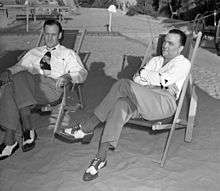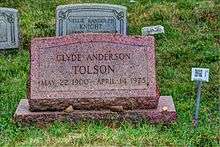Clyde Tolson
Clyde Anderson Tolson (May 22, 1900 – April 14, 1975) was the second-ranking official of the FBI from 1930 until 1972, from 1947 titled Associate Director, primarily responsible for personnel and discipline. He is best known as the protégé and long time top deputy of FBI Director J. Edgar Hoover.
Clyde Tolson | |
|---|---|
 | |
| 1st Associate Director of the Federal Bureau of Investigation | |
| In office 1930 – May 2, 1972 | |
| President | Herbert Hoover Franklin D. Roosevelt Harry S. Truman Dwight D. Eisenhower John F. Kennedy Lyndon B. Johnson Richard Nixon |
| Preceded by | Position established |
| Succeeded by | Mark Felt |
| Acting Director of the Federal Bureau of Investigation | |
| In office May 2, 1972 – May 3, 1972 | |
| President | Richard Nixon |
| Preceded by | J. Edgar Hoover |
| Succeeded by | L. Patrick Gray (acting) |
| Personal details | |
| Born | Clyde Anderson Tolson May 22, 1900 Laredo, Missouri, U.S. |
| Died | April 14, 1975 (aged 74) Washington, D.C., U.S. |
| Education | George Washington University (BA, LLB) |
Early life
Tolson was born in Laredo, Missouri to James William Tolson, a farmer and railroad freight guard,[1] and Joaquin Miller Tolson (née Anderson).[2][3] His brother, Hillory Alfred Tolson (1887–1983), was assistant director of the National Park Service and executive director of the White House Historical Association, and an FBI agent before entering the Park Service.[4][5] Tolson graduated from Laredo High School in 1915 and attended Cedar Rapids Business College from which he graduated in 1918.[6]
Early career
From 1919 to 1928, he was confidential secretary for three Secretaries of War: Newton D. Baker,[7] John W. Weeks, and Dwight F. Davis.[8] Tolson completed a Bachelor of Arts degree at George Washington University in 1925 and a Bachelor of Laws from the same institution in 1927.[3] While attending George Washington University, Tolson became a member of the Delta Pi chapter of Sigma Nu.[9]
Career
In 1928, Tolson applied to the FBI and was hired as a Special Agent later that year. Tolson reportedly indicated on his application that he wanted to use the job as a stepping stone to gain experience and earn enough money to open a law practice in Cedar Rapids.[10] After working in the FBI's Boston and Washington, D.C., field offices, he became the chief FBI clerk and was promoted to assistant director in 1930.
In 1936, Tolson joined Hoover to arrest bank robber Alvin Karpis. Later that year, he survived a gunfight with gangster Harry Brunette.[11] In 1942, Tolson participated in capturing Nazi saboteurs on Long Island and Florida.[12] In 1947, he was made FBI Associate Director with duties in budget and administration.[13]
Relationship with Hoover

It has been stated that J. Edgar Hoover described Tolson as his alter ego: "They rode to and from work together, ate lunch together, traveled together on official business, and even vacationed together."[14] Rumors circulated for years that the two bachelors had a romantic relationship.[15] Some authors dismissed the rumors about Hoover's sexual orientation and possible intimate relationship with Tolson,[16][17][18] while others have described them as probable or even "confirmed",[19][20] and still others reported the rumors without stating an opinion.[21][22]
When Hoover died, Tolson inherited his estate of US$551,000 ($3.4 million today), moved into his house,[11] and accepted the U.S. flag draped on Hoover's coffin.[23]
Later life
In 1964, Tolson suffered a stroke and remained somewhat frail for the remainder of his life.[24] In 1965, President Lyndon B. Johnson awarded him the President's Award for Distinguished Federal Civilian Service, saying that Tolson "has been a vital force in raising the proficiency of law enforcement at all levels and in guiding the Federal Bureau of Investigation to new heights of accomplishment through periods of great National challenge."[25] Hoover kept Tolson employed in the FBI even after Tolson became too old for police duty and passed the retirement age.[11]
After Hoover's death on May 2, 1972, Tolson was briefly the acting head of the FBI.[13] L. Patrick Gray became acting director on May 3.[26] That same day, Tolson contacted Mark Felt and instructed him to write Tolson's letter of resignation.[27] Citing ill health, Tolson retired from the bureau on May 4, the day of Hoover's funeral.[28][29] Felt was appointed to Tolson's position.[30]

After Tolson left the FBI, his health began to decline.[11][31] On April 10, 1975, Tolson was admitted to Doctors Community Hospital in Washington, D.C., for kidney failure.[32] He died there four days later of heart failure at the age of 74.[11] Tolson is buried in the Congressional Cemetery, near Hoover's grave.[24][32]
Depictions in fiction
Tolson has been depicted numerous times in novels, television, and movies, including:
- The 1977 film The Private Files of J. Edgar Hoover portrayed by Dan Dailey
- The 1984 TV movie Concealed Enemies portrayed by Ralph Byers
- The 1987 TV movie J. Edgar Hoover portrayed by actor Robert Harper
- The 1992 TV movie Citizen Cohn portrayed by Daniel von Bargen
- The 1994 satirical radio play "J. Edgar," written by Harry Shearer, portrayed by John Goodman[33][34]
- The 1995 film Nixon portrayed by Brian Bedford
- The 1997 novel Underworld by Don DeLillo[35]
- The 2011 film J. Edgar portrayed by Armie Hammer
- The 2013 TV movie The Curse of Edgar portrayed by actor Anthony Higgins
- The 2015 comic Providence by Alan Moore
References
- American National Biography, vol. 21, John Arthur Garraty, Mark Christopher Carnes, Oxford University Press, 1999, p. 730
- Gelder, Lawrence Van. "Clyde Tolson, Former FBI. Official, Is Dead at 74".
- Kessler, Ronald (2003). The Bureau: The Secret History of the FBI. Macmillan. p. 29. ISBN 0-312-98977-6.
- Who was Who in America, vol. 8, 1982-1985, Marquis Who's Who, 1985, p. 399
- "Hillory Tolson, Park Service Official, Dies" – via www.washingtonpost.com.
- The Delta of Sigma Nu, Volume 81, Issue 3. Sigma Nu Fraternity. 1964. p. 138.
- Jerome, Fred (2003). The Einstein File: J. Edgar Hoover's Secret War Against the World's Most Famous Scientist. Macmillan. p. 168. ISBN 1-429-97588-1.
- Powers, Richard Gid (1987). Secrecy and Power: The Life of J. Edgar Hoover (1 ed.). Free Press. p. 169. ISBN 0-029-25060-9.
- Bond Potter, Claire (1998). War on Crime: Bandits, G-men, and the Politics of Mass Culture. Rutgers University Press. p. 48. ISBN 0-813-52487-3.
- Gentry, Curt (2001). J. Edgar Hoover: The Man and the Secrets. W. W. Norton & Company. p. 189. ISBN 0-393-32128-2.
- Cohen, Richard M. (April 15, 1975). "FBI's Clyde A. Tolson, 74, Dies". The Washington Post. Washington, D.C. p. C6.
- Wicker, Tom (April 9, 1971). "Nobody dares to pick his successor". Life. Time Inc. 70 (13): 44. ISSN 0024-3019.
- (Kessler 2003, p. 49)
- Cox, John Stuart; Theoharis, Athan G. (1988). The Boss: J. Edgar Hoover and the Great American Inquisition. Temple University Press. p. 108. ISBN 0-87722-532-X.
- Bardsley, Marilyn. "The Life and Career of J. Edgar Hoover". Crime Library. Archived from the original (Chapter 6: Homosexual?) on February 9, 2015.
...The relationship was so close, so enduring, and so affectionate that it took the place of marriage for both bachelors.
- Felt, Mark; O'Connor, John D. (2006). A G-man's Life: The FBI, Being 'Deep Throat,' And the Struggle for Honor in Washington. Public Affairs. p. 167. ISBN 1-58648-377-3.
- Jeffreys-Jones, Rhodri (2003). Cloak and Dollar: A History of American Secret Intelligence. Yale University Press. p. 93. ISBN 0-300-10159-7.
- (Cox, Theoharis 1988, p. 108): "The strange likelihood is that Hoover never knew sexual desire at all."
- Percy, William A.; Johansson, Warren (1994). Outing: Shattering the Conspiracy of Silence. Haworth Press. pp. 85+. ISBN 1-56024-419-4.
- Summers, Anthony (1993). Official and Confidential: The Secret Life of J Edgar Hoover. Pocket Books. ISBN 0-671-88087-X.
- Theoharis, Athan G., ed. (1998). The FBI: A Comprehensive Reference Guide. Oryx Press. pp. 291, 301, 397. ISBN 0-89774-991-X.
- Doherty, Thomas (2003). Cold War, Cool Medium: Television, McCarthyism, and American Culture. Columbia University Press. pp. 254–255. ISBN 0-231-12952-1.
- De Toledano, Ralph (1973). J. Edgar Hoover: The Man in His Time. Arlington House. p. 375. ISBN 0-870-00188-4.
- Boggs Roberts, Rebecca; Schmidt, Sandra K. (2012). Historic Congressional Cemetery. Arcadia Publishing. p. 123. ISBN 0-738-59224-2.
- "Lyndon B. Johnson Presidential Library". Lbjlibrary.org. Retrieved January 7, 2012.
- FBI Biography of Gray Archived June 30, 2016, at the Wayback Machine
- (Gentry 2001, p. 43)
- (Gentry 2001, pp. 43, 49)
- Breuer, William B. (1995). J. Edgar Hoover and His G-men. Greenwood Publishing Group. p. 229. ISBN 0-275-94990-7.
- (Gentry 2001, p. 49)
- "G-men under fire". Life. 70 (13): 39. April 9, 1971. ISSN 0024-3019.
- (Gentry 2001, p. 736)
- Los Angeles newspaper reviews, as cited on the CD recording's Amazon.com page.
- Gee, Catherine (March 15, 2011). "Harry Shearer to bring 'J Edgar! The Musical' to London". telegraph.co.uk. Retrieved December 8, 2011.
- Don DeLillo, Underworld (New York: Scribner, 1997), pp. 555-65, 567-79.
External links
| Wikimedia Commons has media related to Clyde Tolson. |
- Associate Director Tolson's personnel records and copies of memoranda at FBI's FOIA Website
- "Clyde Tolson". Find a Grave. Retrieved June 10, 2013.
- Clyde Tolson on IMDb

